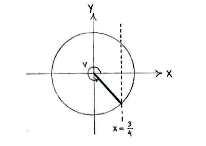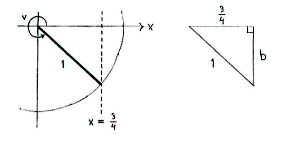Lösung 4.3:6a
Aus Online Mathematik Brückenkurs 1
(Unterschied zwischen Versionen)
K |
|||
| Zeile 1: | Zeile 1: | ||
| - | If we think of the angle v as an angle in the unit circle, then | + | If we think of the angle v as an angle in the unit circle, then ''v'' lies in the fourth quadrant and has ''x''-coordinate 3/4. |
| - | + | ||
| - | lies in the fourth quadrant and has | + | |
| - | + | ||
| - | -coordinate | + | |
| - | + | ||
| - | + | ||
[[Image:4_3_6_a1.gif|center]] | [[Image:4_3_6_a1.gif|center]] | ||
| - | If we enlarge the fourth quadrant, we see that we can make a right-angled triangle with hypotenuse equal to | + | If we enlarge the fourth quadrant, we see that we can make a right-angled triangle with hypotenuse equal to 1 and an opposite side equal to 3/4. |
| - | + | ||
| - | and an opposite side equal to | + | |
| - | + | ||
[[Image:4_3_6_a2.gif|center]] | [[Image:4_3_6_a2.gif|center]] | ||
| - | Using | + | Using the Pythagorean theorem, it is possible to determine the remaining side from |
| - | + | ||
| - | + | ||
| - | + | ||
| - | + | ||
| + | {{Displayed math||<math>b^2 + \Bigl(\frac{3}{4}\Bigr)^2 = 1^2</math>}} | ||
which gives that | which gives that | ||
| + | {{Displayed math||<math>b = \sqrt{1-\Bigl(\frac{3}{4}\Bigr)^2} = \sqrt{1-\frac{9}{16}} = \sqrt{\frac{7}{16}} = \frac{\sqrt{7}}{4}\,\textrm{.}</math>}} | ||
| - | + | Because the angle ''v'' belongs to the fourth quadrant, its ''y''-coordinate is negative and is therefore equal to <math>-b</math>, i.e. | |
| - | + | ||
| - | + | ||
| - | + | ||
| - | + | ||
| - | + | ||
| - | Because the angle | + | |
| - | + | ||
| - | belongs to the fourth quadrant, its | + | |
| - | + | ||
| - | -coordinate is negative and is therefore equal to | + | |
| - | <math>-b</math>, i.e. | + | |
| - | + | ||
| - | + | ||
| - | + | ||
| + | {{Displayed math||<math>\sin v=-\frac{\sqrt{7}}{4}\,\textrm{.}</math>}} | ||
Thus, we have directly that | Thus, we have directly that | ||
| - | + | {{Displayed math||<math>\tan v = \frac{\sin v}{\cos v} = \frac{-\sqrt{7}/4}{3/4} = -\frac{\sqrt{7}}{3}\,\textrm{.}</math>}} | |
| - | <math>\tan v=\frac{\sin v}{\cos v}=\frac{- | + | |
Version vom 07:35, 10. Okt. 2008
If we think of the angle v as an angle in the unit circle, then v lies in the fourth quadrant and has x-coordinate 3/4.
If we enlarge the fourth quadrant, we see that we can make a right-angled triangle with hypotenuse equal to 1 and an opposite side equal to 3/4.
Using the Pythagorean theorem, it is possible to determine the remaining side from
which gives that
Because the angle v belongs to the fourth quadrant, its y-coordinate is negative and is therefore equal to \displaystyle -b, i.e.
Thus, we have directly that


